| Written by Major James A. Harvey III | ||||||||||||
| July 14, 2011 | ||||||||||||
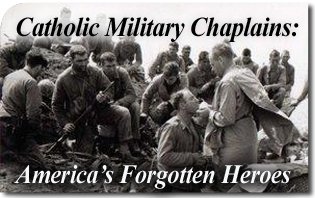
“War is Hell” General William Tecumseh Sherman once noted. Indeed there is nothing to celebrate about warfare; however unfortunately it has been present with mankind in his fallen nature since departing from the Garden of Eden. War was a common affair throughout the Old Testament. Saint Augustine understood the sometimes unfortunate necessity of war and as a result outlined the “Just War” clauses to allow moral principles to still be applied. Later in more modern periods Saint Joan of Arc was called to battle by Our Lord, and in the twentieth century Our Lady noted at Fatima that war was a “punishment for sin.” In other words man’s own sinfulness often leads to war due to a lack of God in society. This helps us in our current age understand that at certain times war is necessary to defeat evil; or in self defense. While often it is hard to tell throughout history whether a war was just or not, in the end it is truly left to the judgment of God. However, regardless Catholic chaplains have served throughout history on the battlefield to serve those who have fought wars whether from a sense of duty, or simply being caught up in the times and circumstances.
The Forgotten Heroes In the U.S., military chaplains have also served since the Revolutionary War. The widespread use of Catholic chaplains did not begin until the Civil War after large populations of Catholic immigrants had changed the demographic of a previously Protestant dominated America. Additionally, previous wars found Catholics still facing much prejudice in the military and their religious needs were not considered as much as those of Protestants. However, since the Civil War, the Catholic chaplains of the U.S. military have provided comfort in war and peace. Frequently many were and remain true Catholic heroes but, sadly are often forgotten. This article while not all inclusive will re-introduce some of the many forgotten Catholic chaplains throughout American military history, and also recommend some additional references for further reading. The Mexican American War Even before the Civil War during the Mexican American War of 1846-1848, Father Anthony Rey served in the army of General Zackary Taylor. Father Rey administered to American troops with Last Rites and care of the wounded. He was present at the Battle of Monterey in which he earned admiration for his bravery. Father Rey also ministered to local Mexican Catholics. He was warned by U.S. Army officers against this practice due to guerilla and bandit activity outside U.S. camps. However, Father Rey accepted the risk nonetheless for the good of souls. He would die doing the work of his Master in 1847 in the Mexican countryside being found dead of multiple lance pierces. A quick internet search will reveal more details and background on the life and mission of Father Rey.1 Civil War Chaplains During the U.S. Civil War from 1861-1865, Father William Corby became famous for his absolution of the Irish brigade at Gettysburg in 1863 as they went into battle. Shortly after this absolution many Irish soldiers would be cut down, but in the mercy of the Lord, they died with the sacramental comfort of the Holy Roman Catholic Church. This act is still commemorated by a statue of the absolution at Gettysburg National Battlefield. Father Corby later became president of Notre Dame and wrote a memoir of his three years in the Civil War which is still in print titled Memoirs of Chaplain Life: Three Years in the Irish Brigade with the Army of the Potomac.2 Also during the Civil War, Father Peter Whelan was a Confederate Army Catholic chaplain who ministered to the Union prisoners at the infamous Andersonville Prisoner of War (POW) camp in Georgia. At Andersonville Union prisoners were subject to exposure at all times and seasons. The stream that flowed through the camp was the water source and latrine. Father Whelan administered to the prisoners in the hot, disease ridden, and filthy camp where thousands would die. Prisoners also suffered from gang violence committed by fellow prisoners. From dawn to dusk Father Whelan heard confessions, cared for the sick, and provided comfort including the Last Rites to the numerous dying. In this camp of horror, Father Whelan saved thousands of lives and souls through his zeal for charity. Father Whelan cared for those seen as the Union “enemy” as he, like his Lord, saw all mankind first: as his brother not an enemy. Father Whelan would contract a lung disease from the disease ridden camp and die in 1871 going to his eternal reward after working in his Master’s vineyard.3 A work titled The Prison Ministry of Father Peter Whelan: Georgia Priest and Confederate Chaplain was written in 1987 by Peter J. Meany, OSB. The small book can sometimes be obtained at old book stores and is quite inspirational and more detailed.4 Later Wars Following the Civil War, conflict was constant in the Western U.S. during the period known as the Indian Wars from 1865 to Wounded Knee in 1890. Father Eli Washington John Lindesmith ministered to the troops and families stationed on the lonely Western outposts. His readings are very interesting and well documented by author Monsignor James R. Kolp in his work The Amazing Father Lindesmith: Chaplain in Indian Country; and noted as “worthwhile reading” by Father Benedict Groeschel CFR.5 The Spanish American War of 1898 began with the explosion that destroyed the U.S.S. Maine in Cuba’s Havana harbor which was likely incorrectly thought to be the result of foul play from Spain. Regardless, Father John P. Chidwick, Chaplain of the U.S.S. Maine, immediately gave a mass absolution, and then feverishly began rescuing and administering to the wounded. Last Rites were also given to the dying. Needless to say all these actions were done at great risk to his own life. One cadet noted that night Chaplain Chidwick was “everywhere.” Father Chidwick would also be one of the last to leave the stricken ship.6
World War I During World War I, Father John B. DeValles would become known as the “Angel of the Trenches.” This was due to his charity in deliberately entering “No Man’s Land” to look for wounded and dying soldiers; Allied or German. The danger he risked in his zeal for souls made him a legend. Father DeValles was once even found unconscious due to breathing in mustard gas while trying to aid a wounded soldier. Father DeValles’ selfless charity would lead to early death from health problems connected to the war at age forty-one.7 Father Francis Patrick Duffy was also a legend and known for his chaplaincy to the 69th “Fighting Irish” New York National Guard in World War I. Today, while not well known, a statue of Father Duffy can be found in the middle of Times Square as this author has visited.8 World War II The attack on Pearl Harbor brought about the first Catholic chaplain hero of World War II. Father Aloysius Schmitt was beginning preparations for Mass on the U.S.S. Oklahoma when Japanese torpedoes hit the battleship. The attack caused immediate flooding aboard the vessel. In one compartment, Father Schmitt helped push sailors through a small porthole to escape the incoming waters. The last man to leave would have been Father Schmitt however, after realizing more sailors had arrived into the flooding compartment below him he went back and gave up attempts to save himself. Father Schmitt pushed another twelve men through before he drowned. Later in the war a destroyer would bear his name as the U.S.S. Schmitt.9 In the following days, the Japanese attacks on the Philippines also brought out more Catholic priest heroes. Father William Cummings was one such chaplain who ministered to the victims of the attack on the Philippines. Eventually captured, Father Cummings would be one of the five priests who participated in the infamous Bataan Death March. Father Cummings would continue to minister to troops in the Prisoner of War (POW) camp and become known as the man “who never said no to anyone.” Father Cummings would go to his eternal award eight months before the war’s end dying on a Japanese POW ship.10 Also on the Death March, the Japanese brutally murdered a Jesuit priest who until today is regarded as a martyr by the Filipino people. Father Juan Gaerlan, a chaplain to the Philippine Army (the Philippines was still an American colony,) after he escaped with other Filipino soldiers was later recaptured. In retaliation all were fastened with baling wire and bayoneted to death.11 Additionally Father John E. Duffy would survive the Death March, being left for dead after Japanese guards bayoneted him three times. Rescued by Filipino guerillas he was later recaptured and sent to Japanese POW camps where he ministered to the prisoners. During his imprisonment Father Duffy was tortured, beaten with a baseball bat and subjected to high water pressure, all of which failed to get the priest to collaborate with the enemy in any way. This information in greater detail is available in a great work on Father Duffy; But Deliver Us from Evil: Father Duffy and the Men of Bataan by Dan Murr in 2008.12 Father Duffy was also with Father Matthias Zerfas who survived the Death March. While a prisoner he celebrated Mass and cared for the sick even though he was weak and himself literally starving to death. Father Zerfas even conducted convert classes and led night prayers and a daily rosary. Father Zerfas eventually died after being given Last Rites by Father Duffy when their POW ship moving them was mistakenly attacked by U.S. warplanes.13 Father Carl Hausmann also ministered to POWs after surviving the Death March. Father Hausmann entered the army following the attack on the Philippines as he was already present in the islands as a priest ministering to the lepers at the Colion Leper Colony. One survivor noted that they felt unclean around Father Hausmann as he was so holy. One example of this holiness was his giving of food to other prisoners although he himself was dying of starvation, and another was how he worked for others while barely able to stand himself. Father Hausmann also suffered a ten minute rifle butt beating by a Japanese guard for refusing to halt the consecration during Mass when an air raid began. Father Hausmann survived the beating and still completed the Holy Mass after the guard left.14 Additionally, Father Duffy himself said Father Hausmann died partly because he gave his daily two spoonfuls of rice to other prisoners.15 This author recommends the aforementioned book by Dan Murr for more detail on these great priests of Bataan and their resulting heroic charity in Japanese POW camps.
The Pacific Theater As the war continued, many Catholic chaplains entered military service and began to bring the sacraments so needed to soldiers in danger or on the verge of death. Many would give their lives or make other heroic sacrifices. In the Pacific War, Father Thomas Reardon suffered with the troops on Guadalcanal so much that he lost fifty pounds. Father Reardon wore the same clothes for eighty-five days and despite dealing with malaria rarely rested in order to minister to his “parish” on the beach for 125 days. Father Reardon was later evacuated unconscious and close to death from his overwork.16 Author James Campbell in The Ghost Mountain Boys regarding the campaign in New Guinea discusses the role of Father Stephen Dzienis who accompanied the 32d Infantry Division as it crossed the Owen Stanley Mountains in a 130-mile march through thick jungle to attack the Japanese army at Buna. This march through the jungle decimated the 32d through disease and exhaustion, but they still went into immediate combat for two months with a determined Japanese enemy. Even in battle and despite jungle rot sores, Father Dzienis would provide Mass, comfort, and Last Rites. Soldiers of all faiths were known to shout “Chaplain Dzienis is here!” so important was his presence as he crawled to the front to visit “his parish.”17 At Iwo Jima, Marine Chaplain Father Charles Suver celebrated Holy Mass shortly before the raising of the U.S. flag on Mount Suribachi by the Marines. Debate has been inconclusive whether it was the first less known or the second more well known raising of the flag that is now immortalized in history. Regardless of which flag raising it was Father Suver could still hear Japanese voices in the nearby caves as he said the Holy Sacrifice of the Mass!18
At sea, Navy Chaplain Father Joseph T. O’Callahan received the Medal of Honor due to his bravery administering to the dead and wounded when the aircraft carrier U.S.S. Franklin was severely damaged and turned into a blazing inferno by a kamikaze attack off Japan in March 1945. Father O’Callahan additionally was credited with inspiring the crew to fight the fires despite the danger of flames and exploding American bombs set off by the fire. Father O’Callahan set an example of bravery and spiritual calmness which in turn helped inspire the crew.19 The European Theater In Europe, Catholic chaplains were no less brave and were present throughout the theater. Father Joseph Lacy spent much of D-Day in France providing Last Rites to Catholic soldiers and spiritual comfort to non-Catholic soldiers.20 Father Francis L. Sampson became known as the “Parachute Padre” serving in the 501st parachute regiment. Father Sampson was captured at Normandy by the German SS and almost executed until saved by a German Catholic soldier. Father Sampson noted he was so nervous he kept repeating the Catholic grace prayer before a meal instead of an Act of Contrition. Eventually freed by American troops and awarded the Distinguished Service Cross, Father Sampson would go on to survive the famous jump into the Arnhem pocket in Holland also known as “the bridge too far,” and was later recaptured by German troops during the Battle of the Bulge. This time Father Samson would remain a POW in a Stalag until the end of the war, but remain busy aiding the sick and saying Mass. Father Sampson would survive to serve as a Chaplain in the Korean War and later become the U.S. Army Chief of Chaplains from 1967-1971.21 Father Sampson also wrote a memoir of his World War II experiences appropriately titled Look Out Below in 1958.22 This memoir also gives great insight to Soviet actions in occupied areas of Eastern Europe after German defeat. Father Sampson was in a POW camp “liberated” by the Soviet army and he offers a good firsthand account of the horrors of life in the Soviet sector. If it can be acquired through an old book store it is a worthwhile read. At sea in the Battle for the Atlantic with German submarines, Father John Washington is remembered as one of the four chaplains that gave away their lives after the troopship Dorchester was torpedoed by a German U-Boat off Greenland in 1943. Father Washington and the other three chaplains a rabbi, a Methodist, and a Dutch Reformed minister all gave away their life preservers and were last seen sinking with the ship praying with arms linked for the men’s safety.23 There is a stained glass memorial to these four chaplains in the Pentagon. In concluding the World War II part of this article it must be mentioned that any reading about Catholic chaplains in World War II is not complete without Battlefield Chaplains: Catholic Priests in World War II by Donald F. Crosby, S.J.
After World War II In the postwar era, Father William Menster would accompany the U.S. exploration mission Operation HighJump to the Antarctica. Father Menster would be the first clergy to set foot on Antarctica and also consecrated the continent through the Holy Mass. Father Menster wrote his memoirs in a work called Strong Men South in 1949.24 In 1950, the Korean War would bring forward more sacrifice on the part of Catholic chaplains. Father Emil J. Kapaun who was declared a Servant of God in 1993 may one day be declared a saint. Father Kapaun worked tirelessly to aid and comfort POWs after he was captured and imprisoned by Chinese Communist troops. Father Kapaun despite abuse would also help the allied POWs refute communist propaganda with Catholic doctrine. Eventually communist abuse would take its toll and Father Kapaun would die of sickness, the denial of medical care, and starvation before the end of the war. Giving away his food to other POWs exasperated the problem. A great work on Father Emil Kapaun is A Shepherd in Combat Boots by William L. Maher.25n Fr. Emil Kapaun, the Good Thief During the war in Vietnam Father Vincent Robert Capodanno, a U.S. Navy Chaplain, ministered to U.S. troops and was killed while trying to rescue a wounded corpsman. Father Capodanno was into his second year after he volunteered to extend past a year in order to continue to administer to U.S. troops. This action would lead to the award of the Medal of Honor for Father Capodanno. Father Capodanno was named a Servant of God in 2002 and may likely become a saint. Grunt Padre by Father Daniel L. Mode is a great book on Father Capodanno.26 U.S. Army Chaplain Father Aloysius Paul McGonigal during the Tet Offensive of 1968 volunteered to minister to troops in the urban battle for Hue city. The urban battle for Hue ranks with other great urban battles like Stalingrad and Manila during World War II in its intensity. Despite an order to not go into the city, Father McGonigal’s zeal for souls in danger was too great.
In our own times, Minnesotan Father Tim Vakoc served in Bosnia where he told his sister he wanted to do God’s will even if it included being in the line of fire. Father Vakoc would eventually deploy to Iraq and drove in the dangerous convoys prone to Improvised Explosive Device (IED) attacks in order to minister to the troops. After returning from saying Holy Mass in the Mosul area in 2004, Father Vakoc was in a vehicle struck by an IED that caused him to loose an eye and suffer heavy brain damage. Father Vakoc suffered during his attempts of recovery and went to his eternal reward in June 2009 a true warrior of Christ. Stella Borealis posts on Father Vakoc While this brief article can only scratch the surface it is a reminder of the many Catholic heroes that have served as chaplains in our country’s history. The spiritual and physical benefits of the priest in service to the armed forces are incalculable. This author has seen firsthand the selfless service of priests in Iraq, and hopes all who read this have a new found appreciation for our wonderful Catholic chaplains past and present and will find the works mentioned beneficial for future reading and inspiration. Our Lord truly built his Holy Roman Catholic Church to bring us salvation and His comfort under the most trying of times in this world. James A. Harvey, III is a Major in the U.S. Army Reserve. He holds a Masters Degree in Military Studies from American Military University. Footnotes1. Donald R. McClarey, “The American Catholic,” http://the-american-catholic.com/2009/03/09/the-first/This is part of a blog regarding Catholic chaplains on “The American Catholic” website that features great information on many forgotten Catholic chaplains. Permission was obtained from author Donald R. McClarey to use them. [back] 2. Corby, William, and Lawrence Kohl. Memoirs of Chaplain Life. New York: Fordham University Press, 1992. [back] 3. Donald R. McClarey “The American Catholic,” http://the-american-catholic.com/2009/04/21/priest-of-andersonville/ This is part of a blog regarding Catholic chaplains on “The American Catholic” website that features great information on many forgotten Catholic chaplains. Permission was obtained from author Donald R. McClarey to use them. [back] 4. Meany, Peter J. The Prison Ministry of Father Peter Whelan Georgia Priest and Confederate Chaplain. Savannah: The Georgia Historical Quarterly, 1987. [back] 5. Kolp, Monsignor. The Amazing Father Lindesmith. Canton, OH: St. Raphael Center, Inc, 2004. [back] 6. Donald R. McClarey, “The American Catholic” http://the-american-catholic.com/2009/07/24/hero-of-the-maine/#more-10928 This is part of a blog regarding Catholic chaplains on “The American Catholic” website that features great information on many forgotten Catholic chaplains. Permission was obtained from author Donald R. McClarey to use them. [back] 7. Sources are hard to find on Father Devalles. The link here is to a daycare center named after Father Devalles and their site presents a quick biography of their namesake. http://www.devallesdaycare.com/our-name.htm [back] 8. Father Duffy’s memoirs are available sometimes in old book sales. Duffy, Francis, P. Father Duffy’s Story A Tale of Humor and Heroism, of Life and Death with the Fighting 69th. New York: George H. Doran Company, 1919. Also available in reprint at Kessinger Publishing http://www.kessinger.net/ [back] 9. Donald R. McClarey “The American Catholic” http://the-american-catholic.com/2009/03/11/sunday-in-paradise/#more-5684 This is part of a blog regarding Catholic chaplains on “The American Catholic” website that features great information on many forgotten Catholic chaplains. Permission was obtained from author Donald R. McClarey to use them. [back] 10. Crosby, Donald F. Battlefield Chaplains: Catholic Priests in World War II. Lawrence: University Press of Kansas, 1994), 27-28. Info on Father Cummings obtained from Battlefield Chaplains. Used with permission. [back] 11. Crosby, Battlefield Chaplains, 29. Used with permission. [back] 12. Murr, Dan. But Deliver Us from Evil: Father Duffy and the Men of Bataan. (Jacksonville, FL: Murr Publishing, 2008), 83-84. Used with permission. [back] 13. Murr, Deliver Us from Evil 100-102. Used with permission. [back] 14. Murr, Deliver Us from Evil 84-86. Used with permission. [back] 15. Murr, Deliver Us from Evil 104. Used with permission. [back] 16. Crosby, Battlefield Chaplains, 40. Used with permission. [back] 17. Campbell, James. The Ghost Mountain Boys. (New York: Crown Publishers, 2007), 255. Used with permission. [back] 18. Donald R. McClarey “The American Catholic” http://the-american-catholic.com/2009/03/30/the-mass-on-mount-suribachi/ This is part of a blog regarding Catholic chaplains on “The American Catholic” website that features great information on many forgotten Catholic chaplains. Permission was obtained from author Donald R. McClarey to use them. [back] 19. Donald R. McClarey “The American Catholic” http://the-american-catholic.com/2010/02/21/great-jesuits-5-medal-of-honor/#more-17858 This is part of a blog regarding Catholic chaplains on “The American Catholic” website that features great information on many forgotten Catholic chaplains. Permission was obtained from author Donald R. McClarey to use them. [back] 20. Crosby, Battlefield Chaplains, 129. Used with permission. [back] 21. Donald R. McClarey, “The American Catholic” http://the-american-catholic.com/2008/11/18/father-major-general/ This is part of a blog regarding Catholic chaplains on “The American Catholic” website that features great information on many forgotten Catholic chaplains. Permission was obtained from author Donald R. McClarey to use them. [back] 22. Sampson, Francis. Look out below! A Story of the Airborne by a Paratrooper Padre. Sweetwater: 101st Airborne Division Association, 1989. [back] 23. Donald R. McClarey, “The American Catholic” http://the-american-catholic.com/2009/01/05/four-chaplains/ This is part of a blog regarding Catholic chaplains on “The American Catholic” website that features great information on many forgotten Catholic chaplains. Permission was obtained from author Donald R. McClarey to use them. [back] 24. Menster, William. Strong Men South. Milwaukee: The Bruce Publishing Company, 1949. [back] 25. Maher, William. A Shepherd in Combat Boots. Shippensburg: Burd Street Press, 2002. [back] 26. Mode, Daniel L. The Grunt Padre. Oak Lawn, IL: CMJ Marian Publishers, 2000. Father Mode himself has served in the U.S. Naval Reserve and is currently on active duty as a chaplain in the U.S. Navy. Father Mode has also served in Afghanistan. [back] 27. Donald R. McClarey, “The American Catholic” http://the-american-catholic.com/2009/05/24/jesuit-grunt/#more-8930 This is part of a blog regarding Catholic chaplains on “The American Catholic” website that features great information on many forgotten Catholic chaplains. Permission was obtained from author Donald R. McClarey to use them. [back] |
Saturday, July 30, 2011
Catholic Military Chaplains: America's Forgotten Heroes
.
Catholic Military Chaplains
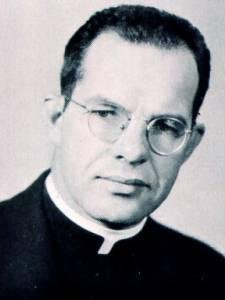
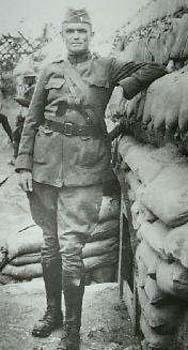
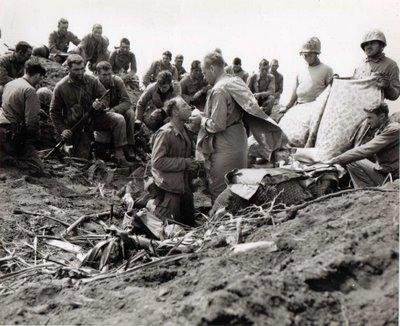
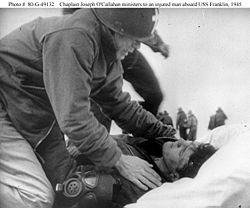
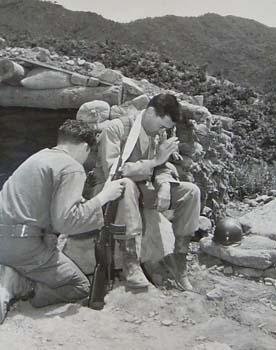
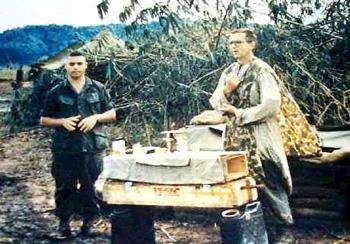

2 comments:
Ray: This is a fantastic summary of Catholic Military Chaplains. Thanks for posting.
Thanks, Cath. I'm working on a longer list of links to all the priests mentioned in the article. But, it is one of many projects that I start and are in various stages of incompleteness.
Who knows what will happen to all chaplains when the morons running the military in this country demand that when homosexuals start requesting marriage ceremonies, chaplains must comply.
Post a Comment